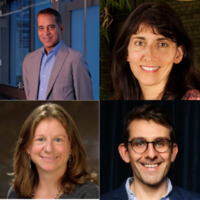CCC @ AAAS 2020 – Using Computing to Sustainably Feed a Growing Population
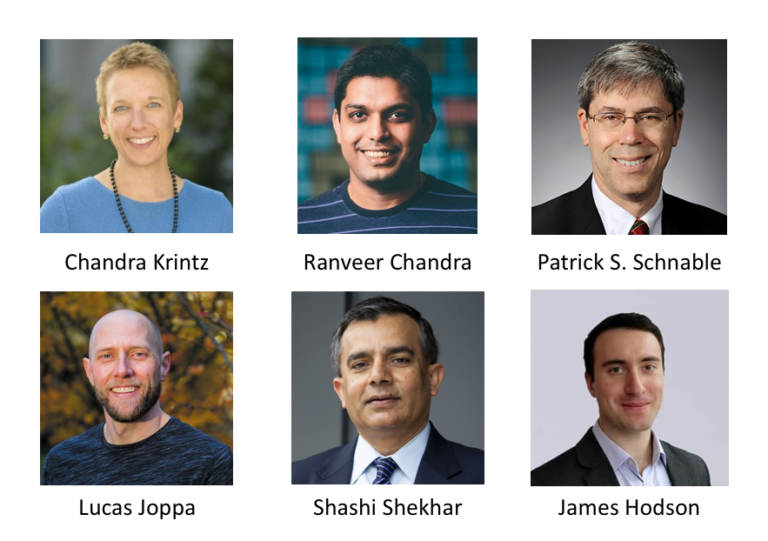
Using Computing to Sustainably Feed a Growing Population speakers and organizers.
As the global population continues to grow, and climate change and pollution lead to environmental degradation, ensuring the future of agriculture and food production becomes increasingly imperative. What role can computing research play in alleviating these challenges going forward? The impact of computing technology on the future of agriculture and plant science was the subject of the Using Computing to Sustainably Feed a Growing Populations scientific session at the 2020 American Association for the Advancement of Science (AAAS) Annual meeting in Seattle, Washington one month ago.
This session was moderated by Lucas Joppa, the Chief Environmental Officer at Microsoft, and co-organized by Shashi Shekhar (CRA Board Member) and James Hodson (AI for Good Foundation). It featured the following speakers:
- Chandra Krintz (Professor, UC Santa Barbara), who highlighted the work of the UCSB SmartFarm, “an open source, hybrid cloud approach to agriculture analytics,” in her presentation SmartFarm – Hybrid Cloud IoT Systems for Future Agriculture;
- Ranveer Chandra (Chief Scientist, Microsoft Azure Global), who shared the work of the Microsoft FarmBeats system, an end-to-end data-driven farming systems that leverages AI and the internet of things (IoT), in his presentation AI and Internet of Things for Agriculture;
- and Patrick S. Schnable (Distinguished Professor, Iowa State University), who discussed his research projects to improve and predict crop performance in diverse environments in his presentation Advancing Plant Science with Predictive Models and Large-scale Phenotyping.
Chandra Krintz opened the session with an explanation of precision agriculture—the practice of using detailed observation and measurement in an agricultural setting to control and optimize return on inputs—and its benefits. Computing technology is a component of modern precision agriculture as it enables more detailed observation and precise control of machinery through sensors and IoT enabled devices. Additionally, AI and data science increase the accuracy of predictions and allow for more complex analysis of observational data. Farms must now use cloud computing resources in order to manage the large numbers of sensors, devices, and data that are required. However, as Krintz explained, accessing the cloud is a challenge due to limited Internet access and bandwidth. IoT is also difficult to use on a farm because many sensors are resource constrained and they must monitor a considerable amount of physical space.
To counter these obstacles, Krintz and UCSB SmartFarm move the cloud closer to the data through on-farm edge systems. UCSB SmartFarm also offers the SPOT Platform, a free and open source application that is designed for on the farm use and is 100 times more power efficient than existing cloud/edge solutions. Krintz concluded her presentation by calling for increased collaborations across disciplines and within academia, government, and industry to continue innovation within precision agriculture.
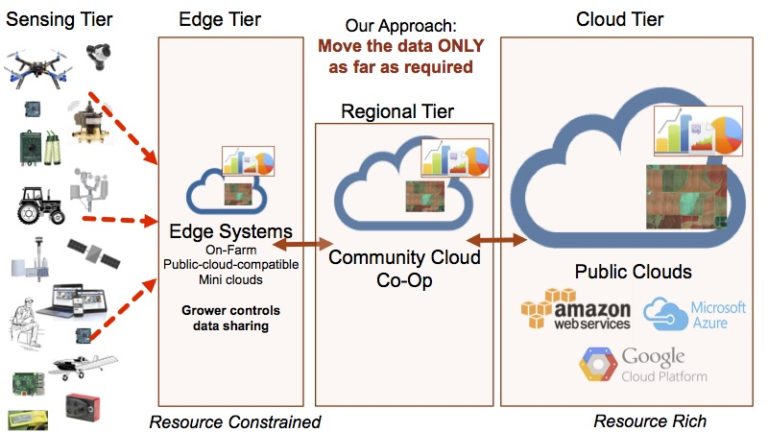
Sensing to cloud tier on a farm.
Ranveer Chandra further explained the pressing challenges facing the agricultural sector. According to Chandra, in order to keep up with population growth we will need 70% more food by 2050, and according to data from the United Nations currently about 10% of people in the world are undernourished[1]. Ranveer started the Microsoft’s FarmBeats project, which leverages AI and IoT to improve farm productivity and lower costs. One innovation FarmBeats has made is the use of TV white space frequencies to carry data signals and improve farms’ access to the Internet. Microsoft’s Networking Over White Spaces (KNOWS) project has been studying this problem for over a decade to connect people and FarmBeats has been able to put it into practice on the farm to connect things.
Another example of novel computing research to assist on the farm is the use of Wi-Fi to measure the amount of moisture in soil. Obviously, soil moisture matters for crop output and being able to accurately measure and track levels of moisture can help farmers improve yields. Traditional soil moisture sensors are expensive, however Wi-Fi is cheap and easily available. Ranveer Chandra and Jian Ding from Microsoft Research have proposed the Soil Measurements Using RF or SMURF system, which “uses Wi-Fi devices in the unlicensed 2.4 GHz of spectrum, with multiple antennas placed at different depths in the soil. A wireless transmitter…emits signals that are received by these antennas in soil. The receiver uses signals on multiple antennas to compute soil permittivity. The results are then transmitted back to the soil surveying device, which then computes the soil moisture and soil EC values at the location of the antenna.”[2] Learn more about this idea in the Estimating Soil Moisture and Electrical Conductivity Using Wi-Fi paper by Ranveer Chandra and Jian Ding.
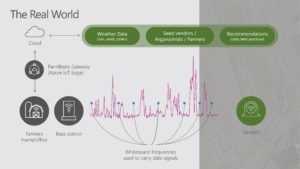
How FarmBeats uses TV white space.
Finally, agronomist Pat Schnable touted the promise of predictive models for plant science. With sufficient genotyping, phenotyping, and environmental data we will be able to build predictive models to improve the accuracy of selection in plant breeding programs, enhance our ability to breed crops for future environments, and increase yields and yield stability. He also described two novel phenotyping tools. A nitrate-specific sensor offers the promise of being able to more accurately advise farmers on appropriate levels of fertilization, thereby increasing both farmer profitability and the sustainability of agriculture. The “plant tattoo” is a novel sensor made of graphene oxide. Exposure to water vapor changes the conductivity of the graphene oxide, thus allowing for accurate measurements of crop transpiration, thereby offering the possibility of breeding more water-efficient crops and fine-tuning irrigation schedules. Schnable also highlighted the Genomes to Fields (G2F) Initiative, a public-private partnership he is involved with that works “to support translation of maize genomic information for the benefit of growers, consumers and society.” Learn more about the G2F funded projects on their webpage.
During the Q&A, Ranveer Chandra was asked if there were any regulatory challenges with getting TV white space approved for use in farms. Ranveer said that the FCC has approved this[3] and that FarmBeats is working with regulators in other countries to get TV white space approved for use on the farm.
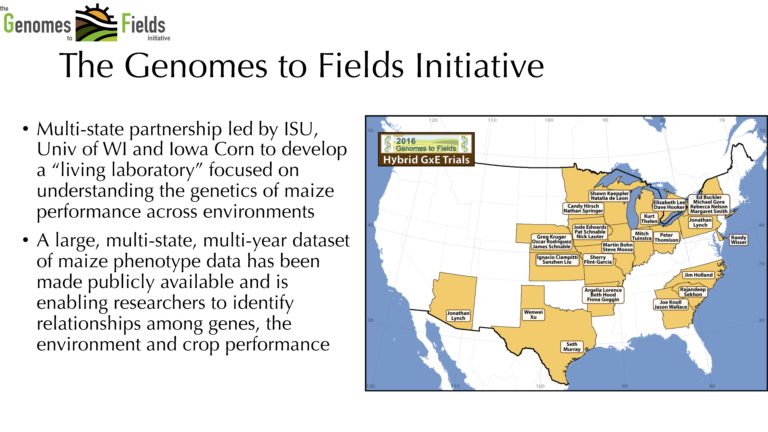
The Genomes to Fields Initiative.
The panel was also asked what the scientific community can do to build resilient plants in the face of climate change. Chandra Krintz replied that though climate change might limit crop growth in some areas, non-traditional farming areas might become conducive to growing and computing could be helpful to identify and develop those areas for growing crops in the future.
View all the slides and learn more about the ”Using Computing to Sustainably Feed a Growing Population” session on the CCC @ AAAS webpage.
Related Links:
- Intelligent Infrastructure for Smart Agriculture, CRA CCC Blog, July 11th, 2017.
- Agriculture Big Data (AgBD) Challenges and Opportunities From Farm To Table: A Midwest Big Data Hub Community Whitepaper, , S. Shekhar, P. Schnable, D. LeBauer, K. Baylis, and K. VanderWaal, NSF Midwest Big Data Hub, December, 2017.
- NSF Workshop to Identify Interdisciplinary Data Science Approaches and Challenges to Enhance Understanding of Interactions of Food Systems with Energy and Water Systems , Computing Research News (ISSN 1069-384X), Computing Research Association, 27(10), November 2015.
- Capitol Hill Presentation on Deconstructing Precision Agriculture , Computing Research News (ISSN 1069-384X), Computing Research Association, 27(4), April 2015.
[1] https://unstats.un.org/sdgs/files/report/2017/thesustainabledevelopmentgoalsreport2017.pdf
[2] https://www.microsoft.com/en-us/research/uploads/prod/2018/10/SMURF_TR-1.pdf
[3] https://www.fcc.gov/general/white-space









